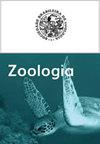The effects of rainfall and arthropod abundance on breeding season of insectivorous birds, in a semi-arid neotropical environment
IF 1.8
4区 生物学
Q4 ZOOLOGY
引用次数: 13
Abstract
Rainfall in tropical semi-arid areas may act as a reliable cue for timing bird reproduction, since it precedes future food supply. With this in mind, we set-up a study to test the reproductive response of insectivorous bird to arthropod abundance and rainfall patterns. Sampling occurred in a seasonally dry Neotropical forest, in north-eastern Brazil, between October, 2015 and October 2016, at 14-day intervals. We used brood patch to assess reproductive periodicity of insectivorous birds (eight species, 475 captures, 121 patch records). We sampled arthropods to quantify abundance, using biomass and number of individuals (1755 individuals, 15 Orders). Rainfall temporal distribution was analyzed using daily precipitation data. We used a cross-correlation function to test for correlation and time-lags between the covariates under study. Both the number of reproductively-active birds and arthropod abundance were higher in time periods close to the rainy season. Increase in arthropod biomass in the aerial stratum preceded the period of greatest rainfall by one (14 days, r = 0.44) to three sampling periods (0.47). In contrast, the highest proportion of individuals with brood patches occurred after the main rainfall peak, with the strongest relationship occurring after two (0.52) to four (0.50) time lags. Finally, the proportion of individuals with brood patches was positively correlated with aerial stratum arthropod biomass when five time lags were considered (0.55). Our results support the hypothesis of a temporal process involving rainfall, arthropods and reproduction of insectivorous birds in the wet/dry tropics. However, rainfall did not appear to act as a cue for the timing of reproduction, since records indicated higher arthropod biomass before the main rainfall peak. At least occasionally in the study area, insectivorous bird reproduction peaks after food abundance.半干旱新热带环境中降雨和节肢动物丰度对食虫鸟类繁殖季节的影响
热带半干旱地区的降雨可以作为确定鸟类繁殖时间的可靠线索,因为它先于未来的食物供应。考虑到这一点,我们建立了一项研究,以测试食虫鸟类对节肢动物丰度和降雨模式的生殖反应。采样于2015年10月至2016年10月期间在巴西东北部的季节性干燥新热带森林中进行,每隔14天采样一次。采用育雏斑块法对8种食虫鸟类的繁殖周期进行了评价(475次捕获,121次斑块记录)。利用生物量和个体数对节肢动物的丰度进行了量化(15目1755个个体)。利用日降水资料分析降水时间分布。我们使用交叉相关函数来检验所研究的协变量之间的相关性和时间滞后。临近雨季时,繁殖活跃的鸟类数量和节肢动物丰度均较高。空中层节肢动物生物量的增加比最大降雨期提前1天(14 d, r = 0.44)至3个采样期(0.47)。巢斑个体比例在主雨峰后最高,在2 ~ 4个时间滞后(0.52 ~ 0.50)时关系最强。考虑5个时间滞后时,育雏斑块个体比例与地层层节肢动物生物量呈正相关(0.55)。我们的研究结果支持了降雨、节肢动物和食虫鸟类在湿/干热带地区繁殖的时间过程的假设。然而,降雨似乎并没有作为繁殖时间的线索,因为记录表明节肢动物的生物量在主要降雨高峰之前较高。至少偶尔在研究区域,食虫鸟类的繁殖在食物丰富后达到高峰。
本文章由计算机程序翻译,如有差异,请以英文原文为准。
求助全文
约1分钟内获得全文
求助全文
来源期刊

Zoologia
生物-动物学
自引率
0.00%
发文量
15
期刊介绍:
Zoologia, the scientific journal of the Sociedade Brasileira de Zoologia (SBZ), is an international peer-reviewed, open-access Zoological journal that publishes original research on systematics, evolution, taxonomy, nomenclature, biogeography, morphology, physiology, biology, ecology, symbiosis, conservation, behavior, genetics and allied fields. The journal, formerly known as Revista Brasileira de Zoologia, publishes original articles authored by both members and non-members of the Society. The manuscripts should be written exclusively in English.
 求助内容:
求助内容: 应助结果提醒方式:
应助结果提醒方式:


